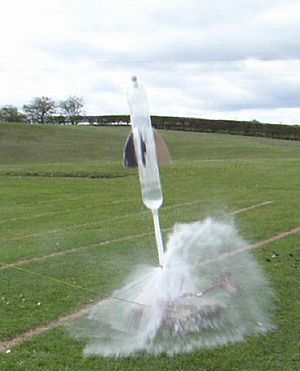Water rocket facts for kids
A water rocket is a type of model rocket that uses water as its fuel! It's a fun way to learn about science and engineering. Imagine a plastic bottle filled with some water and then pumped full of air. When you release it, the air pushes the water out very fast, and the bottle shoots into the sky! This happens because of a scientific rule called Newton's Third Law of Motion.
Contents
How Water Rockets Fly
Water rockets work using a simple but powerful idea: for every action, there is an equal and opposite reaction.
Pressure and Propulsion
When you pump air into a bottle with water, the air gets squished, or "pressurized." This pressurized air wants to escape. When you launch the rocket, a special valve opens, and the air pushes the water out of the bottom of the bottle at high speed. This fast-moving water creates a force that pushes the rocket in the opposite direction – upwards! This is called propulsion.
The Role of Water
You might wonder why water is used. Water is much heavier than air. When the pressurized air pushes out the heavy water, it creates a stronger push, or "thrust," than if it just pushed out air. This strong thrust is what makes the rocket fly high.
Parts of a Water Rocket
Even though they look simple, water rockets have a few important parts that help them fly straight and high.
The Bottle Body
The main part of a water rocket is usually a strong plastic bottle, like a soda bottle. It needs to be strong enough to hold the pressurized air without bursting. This bottle holds both the water and the air.
Nose Cone
The nose cone is the pointy part at the top of the rocket. It helps the rocket cut through the air more easily, reducing "drag." This makes the rocket fly higher and more smoothly. Nose cones can be made from various light materials.
Fins
Fins are attached to the bottom part of the rocket. They help keep the rocket stable and flying straight, just like the feathers on an arrow. Without fins, a water rocket would tumble and spin out of control. Most rockets have three or four fins.
Launch Pad
A launch pad is a special stand that holds the rocket upright before launch. It also has a mechanism to release the rocket safely and quickly. Some launch pads can be quite simple, while others are more complex.
Building Your Own Water Rocket
Making a water rocket can be a fun project! You can use everyday materials to build one.
Basic Materials
- A strong plastic soda bottle (1 or 2 liters works well)
- Cardboard or plastic for fins
- A plastic cup or another bottle top for the nose cone
- Strong tape or glue
- A bicycle pump or air compressor
- A launch pad (you can buy one or build a simple one)
Simple Steps to Build
1. Prepare the bottle: Make sure it's clean and empty. 2. Add fins: Cut out three or four identical fins from cardboard or plastic. Tape or glue them evenly around the bottom of the bottle. Make sure they are straight. 3. Make a nose cone: Shape a plastic cup or another bottle top into a cone. Attach it to the top of the bottle. You can add some weight to the nose cone (like clay) to help the rocket fly better. 4. Decorate: You can decorate your rocket with paint or stickers to make it look cool!
Launching a Water Rocket Safely
Safety is super important when launching water rockets. Always have an adult help you, especially with the air pump and launch.
Choose a Safe Area
Launch your rocket in a large, open area, far away from people, buildings, trees, and power lines. A big field or park is usually a good choice.
Wear Safety Gear
Always wear safety glasses to protect your eyes. The rocket can launch very fast, and sometimes parts can come off.
Filling and Pumping
Fill the bottle about one-third full with water. Then, attach it to the launch pad. Use the pump to add air until the pressure is right for your launch pad. Never over-pressurize the bottle, as it could burst.
Counting Down and Launching
Once everything is ready and everyone is standing far back, do a countdown! Then, activate the launch mechanism. Watch your rocket soar!
Why Water Rockets Are Awesome
Water rockets are more than just toys; they are great tools for learning.
Learning Science
They teach you about physics, like Newton's laws, pressure, aerodynamics, and gravity. You can experiment with different amounts of water or air pressure to see how high your rocket flies.
Engineering Skills
Building a water rocket helps you practice engineering skills. You learn about design, construction, and problem-solving as you try to make your rocket fly better.
Fun and Competition
Launching water rockets is a lot of fun! You can even have friendly competitions with friends to see whose rocket flies the highest or lands closest to a target.
Images for kids
-
Two multi-bottle rockets with a cat for scale.
See also
 In Spanish: Cohete de agua para niños
In Spanish: Cohete de agua para niños













